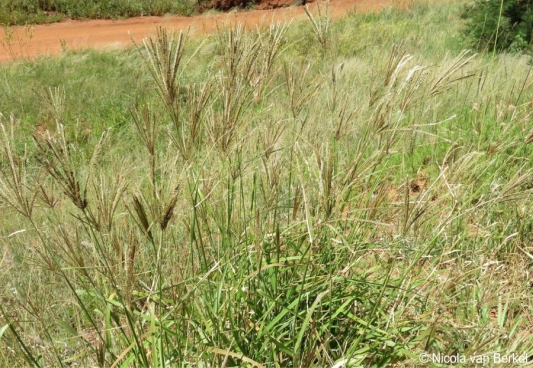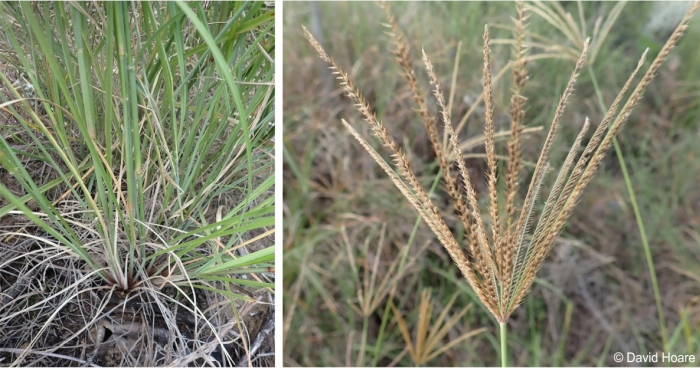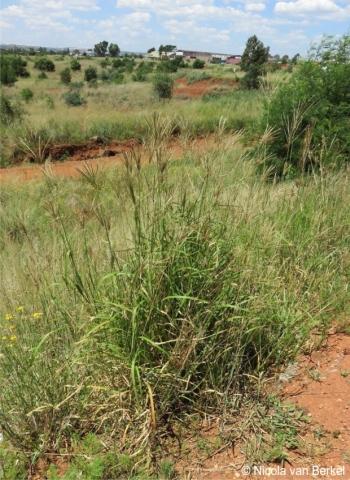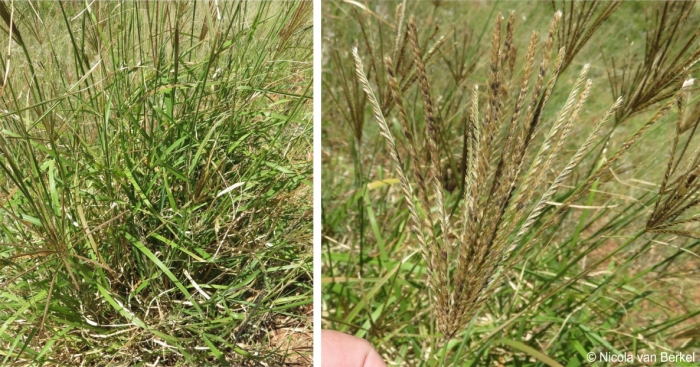Chloris gayana
Chloris gayana Kunth
Family: Poaceae
Common names: Hunyani grass, Rhodes grass, Rhodesian blue grass (Eng.); bruinvingergras, rhodes-gras, rooiklossiegras (Afr.); nyankomo, umyaka (isiZulu)
Introduction
Rhodes grass is a very leafy grass which spreads by means of stolons. It is a fairly distinctive grass, not easily confused with other grasses.

Description
Description
Chloris gayana is a tufted perennial, growing 500–1 200 mm high, with stolons. Basal leaf sheaths are strongly keeled. Leaf blade is 250–500 × 3–9 mm, tapering to a fine point. Inflorescence is digitate, racemes 7–20, 40–150 mm long, green, greenish-brown or light brown; spikelets overlapping for most of their length. Spikelet is 3–5 mm long, 3 or 4-flowered. Lower glume 1.5–2.5 mm long; upper glume 2–4 mm long. Lowest lemma 2.5–3.5 mm long, lanceolate-ovate, sparsely to densely hairy on the margins and keel, with hair length increasing upwards on margins, sometimes margins hairy only near apex, apical hairs 0.5–1.0 mm long, awn 3.4–7.0 mm long, callus rounded; second lemma 1.5–3.0 mm long, lanceolate, glabrous or rarely hairy on the margins and keel, awn 1.5–5.5 mm long; third lemma reduced to an awnless, glabrous, clavate scale 0.75–2.00 mm long, occasionally similar to the second, then with a rudimentary fourth floret; anther 1.0–1.5 mm long. Chloris gayana flowers in early and late summer, from November to May.

Conservation Status
Status
The current conservation status of Chloris gayana, according to the Red List of South African plants, has been assessed as Least concern (LC). Rhodes grass is a very good grazing grass, but does not generally occur in the natural veld.
Distribution and habitat
Distribution description
Chloris gayana is a widespread grass species that grows from southern Africa northwards to tropical Africa; introduced and naturalised in many parts of the world. Cultivated as pasture in Australia, extending to New Zealand and North America. In South Africa, Chloris gayana is dominant and occurs in Limpopo, North West, Gauteng, Mpumalanga, Free State, KwaZulu-Natal and the Western and Eastern Cape Provinces. It also occurs in Namibia, Botswana and Eswatini (formerly Swaziland).
This grass grows well in an ordinary dryland conditions and on all types of soil. It also favours growing in moist areas near river banks, alluvial flood plains and vleis, except in the higher rainfall areas where it grows in grassland extending into open woodland.

Derivation of name and historical aspects
History
The genus Chloris is named after the Greek goddess of flowers. The reason behind the species name gayana is unknown. This species was described originally from Senegal, and it seems possible that the name gayana is derived from Gaya, a settlement on the river Niger, alternatively it could be named after the French botanist Jacques Etienne Gay (1786-1864).
Chloris gayana was introduced to cultivation at Groote Schuur (in Cape Town) by Cecil Rhodes in about 1895, from India.
The genus Chloris has ± 55 species, occurring in tropical and warm temperate regions; 8 species occur in southern Africa where they are widespread.

Ecology
Ecology
Chloris gayana is found in open woodland and grassland, riverine and lake margins, and seasonally waterlogged plains, on a wide range of soils. It is spreads vegetatively by ‘looping’ stolons and by seed that is readily carried by wind or by adhering to animal fur. It is mostly wind pollinated and recovers very well after fire. Chloris gayana invades in disturbed ground and can be a weed of cultivation.
Uses
Use
This is an excellent forage grass. It is a cultivated pasture and is a good grazing grass of high nutritional value, and used for crop rotation (some geographical strains, e.g. Katambore Rhodes grass from Botswana, is resistant to eelworm). Rhodes grass is a perfect grass for stabilising disturbed soil and also used to control soil erosion along new roads and dam walls. In Zimbabwe, this grass is used as a ley in tobacco rotations, because it is highly resistant to certain nematodes.

Growing Chloris gayana
Grow
In cultivation, Chloris gayana is usually planted in areas with rainfall from 700 to 1 200 mm, but has been successfully grown in regions with lower annual averages. It is popular in irrigated pastures, particularly where irrigation water may be too saline for other species.
Chloris gayana is propagated vegetatively or from seed. Planting material can be obtained by breaking up larger clumps into pieces, or using the small tussocks along the stolons that establish readily. This grass can be planted on about a 1 m grid. Therefore, when this grass is planted from seed, it is usually at sowing rates of 0.5‒1 kg/ha. Seed germinates in 1‒7 days, and seedlings develop rapidly.
Although Chloris gayana can survive on infertile soil, it is very unproductive, and may eventually die out, particularly if grazed regularly. It responds to phosphorus in poorer soils, and gives a linear yield and crude protein response of up to 300 kg/ha of nitrogen if other nutrients are adequately supplied. It grows well with temperate and tropical legumes, by virtue of its open stoloniferous ground cover.
References
- Bogdan, A.V. 1961. Intra variety variation in Rhodes grass (Chloris gayana Kunth.) in Kenya. Grass and Forage Science 16: 238–239. doi.org/10.1111/j.1365-2494.1961.tb00243.x
- Bogdan, A.V. 1977. Tropical Pasture and Fodder Plants. Longman Inc., New York, USA.
- Cook, B.G., et al. 2020. Tropical Forages: An interactive selection tool. 2nd and Revised Edn. International Center for Tropical Agriculture (CIAT), Cali, Colombia and International Livestock Research Institute (ILRI), Nairobi, Kenya.
- Fish, L., Mashau, A.C., Moeaha, M.J. & Nembudani, M.T. 2015. Identification guide to southern African grasses. Strelitzia 36: 271–276. South African National Biodiversity Institute, Pretoria.
- Hoare, D. 2023. Observation of Chloris gayana, Eden, Western Cape. iNaturalist. Online. https://www.inaturalist.org/observations/155730287.
- Leistner, O.A. (ed.). 2000. Seed plants of southern Africa: families and genera. Strelitzia 10. National Botanical Institute, Pretoria.
- Loch, D.S. & Harvey, G.L. 1999. Chloris gayana in Australia. In: Loch, D.S. and Ferguson, J.E. (eds) Forage seed production, Volume 2: Tropical and subtropical species. CABI Publishing, Wallingford, Oxon, UK.
- Massyn, A. 2019. Observation of Chloris gayana, Kampersrus R531, Mpumalanga. iNaturalist. Online. https://www.inaturalist.org/observations/32291147.
- Raimondo, D., Von Staden, L., Foden, W., Victor, J.E., Helme, N.A., Turner, R.C., Kamundi, D.A. & Manyama, P.A. (eds) 2009. Red list of South African plants. Strelitzia 25. South African National Biodiversity Institute, Pretoria.
- Van Berkel, N. 2015. Observation of Chloris gayana, Lenasia, Gauteng. iNaturalist. Online. https://www.inaturalist.org/observations/11160936.
- Van Oudtshoorn, F. 1999. Guide to the grasses of southern Africa. Briza Publications, Pretoria.
Credits
Aluoneswi Caroline Mashau
National Herbarium (PRE), Pretoria
July 2023
Acknowledgements: images by David Hoare, Andrew Massyn and Nicola van Berkel.
Plant Attributes:
Plant Type: Grass
SA Distribution: Eastern Cape, Free State, Gauteng, KwaZulu-Natal, Limpopo, Mpumalanga, North West, Western Cape
Soil type: Sandy, Clay, Loam
Flowering season: Early Summer, Late Summer
PH:
Flower colour: Brown
Aspect: Full Sun
Gardening skill: Easy
Special Features:
Horticultural zones










Rate this article
Article well written and informative
Rate this plant
Is this an interesting plant?
Login to add your Comment
Back to topNot registered yet? Click here to register.